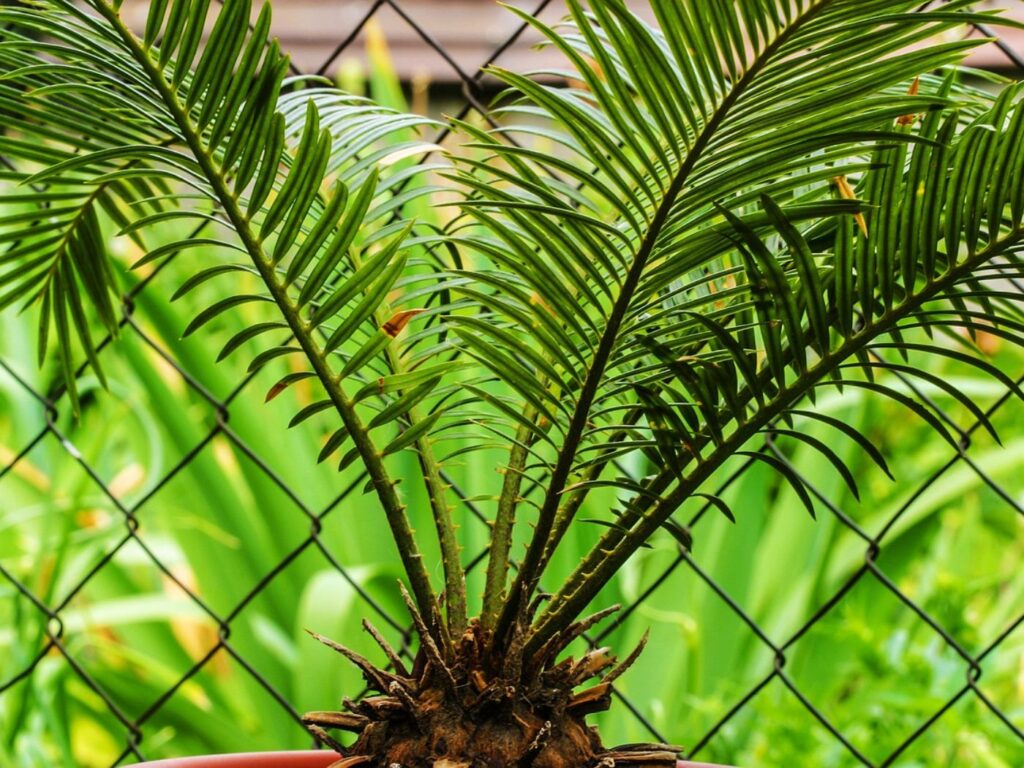Embarking on the journey of planting and growing a Sago Palm can transform your garden into a lush, tropical paradise. Often admired for its striking appearance, this ancient plant requires specific care and attention to truly thrive. If you’ve ever admired the majestic Sago Palm and wondered how to incorporate this exotic beauty into your own garden space, you’re in the right place.
Understanding the needs of the Sago Palm is crucial for its successful growth. From selecting the perfect spot in your garden to mastering the watering and feeding schedule, each step is vital.
This article will guide you through the essential steps, ensuring your Sago Palm not only survives but flourishes. Let’s unlock the secrets to nurturing this prehistoric beauty, turning your gardening aspirations into reality.
Understanding Sago Palm Basics

What Is Sago Palm?
Sago Palm, scientifically known as Cycas revoluta, stands out as an ancient plant species that’s been around longer than you may well expect, dating back to the dinosaur era. This plant isn’t actually a palm but a cycad, a group of seed plants with a rich history.
Known for its lush, feather-like foliage and rugged, shaggy trunk, the Sago Palm adds a prehistoric yet elegant touch to any garden setting. Its resilience and ease of care make it a popular choice for gardeners looking to inject a tropical vibe into their landscapes.
The Growth Habits of Sago Palm
Growing a Sago Palm is a test of patience but highly rewarding. Typically, this plant exhibits slow growth, adding only about 1 to 2 inches per year. Under optimal conditions, expect it to reach heights of 10 to 12 feet, although indoor specimens usually cap at a much smaller size.
The Sago Palm is known for its symmetrical growth and the production of new fronds from the center of the crown, creating a dense, umbrella-like canopy. Recognizing these growth habits is crucial for providing the right care and conditions for your Sago Palm to thrive.
Selecting a Planting Location
Ideal Soil Conditions for Sago Palm
For your Sago Palm to thrive, focusing on soil composition is key. Aim for well-draining soil that’s rich in organic matter. A mix that ensures quick drainage can prevent root rot, a common problem in waterlogged soils.
Adjusting your garden’s soil by incorporating sand or perlite will improve its structure, benefiting your Sago Palm’s root health and overall growth. Remember, a happy Sago Palm roots in soil that feels more like a cozy, breathable blanket than a wet, compacted jacket.
Sunlight and Shade Requirements
Your Sago Palm loves the sun but appreciates a break during the peak hours. A location that offers bright, indirect light or partial shade suits it best. If you plant it in an area that gets full sun, observe for signs of scorching on the fronds, which can indicate too much direct light.
On the flip side, too much shade can lead to sparse, leggy growth. Finding that sweet spot, where your Sago Palm gets enough light to photosynthesize efficiently without getting a sunburn, will set it on the path to becoming a stunning garden centerpiece.
Planting Your Sago Palm
When to Plant Sago Palm
The ideal time to plant a Sago Palm is during the spring. This period allows the plant to establish itself in the warm growing season ahead, taking full advantage of the longer days and optimal growth conditions. Avoid cooler months, as the chilly weather can hinder root development, putting your plant at a disadvantage right from the start.
- Choose the Right Spot: Select a location that offers well-draining soil and partial sunlight. Sago Palms appreciate a bit of shade from the harsh afternoon sun, yet they thrive with morning light.
- Prepare the Soil: Mix the native soil with compost to improve drainage and nutrient content. Sago Palms aren’t too fussy but they dislike waterlogged roots, so ensuring good drainage is key.
- Dig a Hole: The hole should be twice as wide and just as deep as the root ball of your Sago Palm. This gives the roots ample room to spread out.
- Place the Plant: Gently remove the Sago Palm from its container, tease out the roots slightly, and place it in the hole. Ensure the top of the root ball is level with the surrounding soil surface to promote proper growth.
- Backfill and Water: Fill the hole with the improved soil, patting down lightly to remove air pockets. Water the plant thoroughly after planting to settle the soil around the roots and ensure good contact.
By following these steps, you’ll provide your Sago Palm with a solid foundation for a healthy and prosperous life in your garden. Remember, a well-planted Sago Palm is the first step toward creating that tropical paradise in your backyard.
Caring for Your Sago Palm
After settling your Sago Palm into its new home, proper care becomes key to ensuring its success. Let’s dive into how to keep your palm thriving through watering, fertilizing, and regular maintenance.
Watering Your Sago Palm
Watering practices can make or break your Sago Palm. These plants prefer a “just right” amount of water—not too much, not too little. Aim for moist soil, but avoid waterlogging, as standing water can lead to root rot.
During hotter months, weekly watering keeps the soil properly hydrated. In cooler seasons, reducing to bi-weekly or even less prevents over-saturation. Remember, it’s better to err on the side of dryness than drown your palm in enthusiasm.
Fertilizing Techniques
Feeding your Sago Palm correctly plays a crucial role in its growth. These palms enjoy a balanced, slow-release fertilizer during their active growing season in spring and summer.
Apply a palm-specific fertilizer every two months to support healthy development. Avoid over-fertilizing, as it can harm more than help, leading to nutrient burn or even stunted growth. Just like a well-seasoned dish, the right amount of fertilizer enhances your palm’s health without overwhelming it.
Pruning and Maintenance Tips
Keeping your Sago Palm looking sharp is not just about aesthetics; it’s about health. Prune dead or yellowing fronds with clean, sharp shears to prevent fungal infections and encourage new growth.
Also, watch for pests such as scale insects, which find Sago Palms particularly inviting. A gentle soap solution or neem oil can work wonders in keeping these critters at bay. Remember, a little grooming goes a long way in the life of your palm, helping it stay vibrant and robust.
Troubleshooting Common Issues
Pests and Diseases Affecting Sago Palm
Sago Palms, while sturdy, can fall victim to certain pests and diseases that threaten their health. Scale insects and spider mites top the list, often latching onto the undersides of leaves and causing damage. If you spot these pests, a simple solution involves washing them off with a strong jet of water or applying horticultural oil for more severe infestations.
Diseases such as root rot pose a greater challenge, usually stemming from overwatering. To combat this, check your watering routine, making sure not to let the soil get too soggy. Remember, prevention plays a crucial role. Regular inspections can help catch these issues early, making them easier to manage.
Dealing with Yellowing Leaves and Other Symptoms
Encountering yellowing leaves on your Sago Palm may well initially stir panic, but there’s often a straightforward fix. Yellow leaves typically indicate a lack of essential nutrients, especially magnesium or potassium. Adding a slow-release palm fertilizer can address this deficiency, restoring your palm’s vibrant green color.
Other symptoms, like brown tipping or frond damage, can result from environmental stresses, including too much direct sunlight or improper watering. Adjusting your care regimen, such as providing more shade or moderating water usage, can alleviate these symptoms. Always trim away damaged fronds to encourage new growth and maintain your palm’s aesthetic appeal.
Propagating Sago Palm
Methods for Propagating Sago Palm
Propagating Sago Palm involves two main methods: seed propagation and pup division. If you’re feeling patient, seed propagation is your go-to. After collecting seeds from a female plant, soak them in water for 24 hours to enhance germination.
Plant the seeds in a sandy, well-draining soil mix, and keep them warm and moist. Germination can take anywhere from 3 to 9 months, so prepare for a bit of a wait.
Pup division, conversely, offers a quicker path to growing new plants. Often found at the base of the parent plant, pups can be carefully removed by cutting them away with a sharp, sterilized knife.
Ensure the pup has a clean cut and let it dry for a few days to form a callus. Once ready, plant the pup in a similar well-draining soil mixture and wait for it to take root, usually within a few weeks.
Tips for Successful Propagation
Success in propagating Sago Palms begins with choosing the right time of year, ideally during warmer months when the plant is actively growing. Whether you’re starting from seed or pup, maintaining a warm, moist environment without overwatering is crucial to encourage rooting and germination.
Patience is key, especially with seeds, which may well test your waiting skills. Keep an eye out for signs of growth but resist the temptation to disturb the plant. For those propagating by pups, ensuring that your tools are clean and the cuts are precise are non-negotiable steps for avoiding infection and promoting healthy growth.
Remember, Sago Palms are slow growers. Even with optimal conditions, these plants take their sweet time to show progress. Celebrate the small victories, like the first signs of germination or when a pup finally establishes roots. Your patience and care will eventually be rewarded with a beautiful addition to your garden.
Frequently Asked Questions
What is a Sago Palm?
A Sago Palm, scientifically known as Cycas revoluta, is a slow-growing plant that resembles palm trees and is prized for creating a tropical ambiance in landscapes.
How do you plant a Sago Palm?
To plant a Sago Palm, select a location with well-draining soil and sufficient sunlight. Plant the palm in a hole twice the size of its root ball, backfilling with soil and ensuring it’s well-watered after planting.
What care does a Sago Palm need after planting?
After planting, Sago Palms require regular watering to establish roots, without overwatering. They benefit from a balanced, slow-release fertilizer and need pruning to remove dead foliage.
How can you propagate a Sago Palm?
Sago Palms can be propagated through seed propagation or pup division. Both methods require a warm, moist environment and patience, as the plant grows slowly.
When is the best time for propagating Sago Palms?
The best time for propagating Sago Palms is during warmer months when the temperature and moisture levels support the growth of seeds or pups.
How do you ensure successful Sago Palm propagation by pups?
To ensure successful propagation by pups, use a clean, sharp tool for removal from the parent plant to prevent infection. Maintain a moist environment and be patient, as pups take time to establish and grow.
Why is cleanliness important in propagating Sago Palms by pups?
Cleanliness prevents infections in both the parent plant and pup. Using sterilized tools and maintaining a clean environment ensures healthy growth and reduces the risk of disease.
How long does it take for a Sago Palm to grow?
Sago Palms are notably slow growers. Even with optimal care, expect a slow rate of growth, with patience being key to eventually enjoying their tropical beauty in your garden.
Up next:







